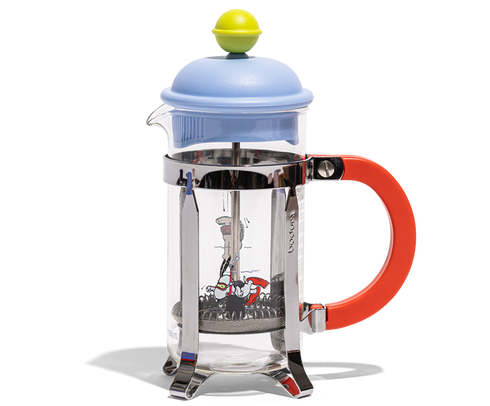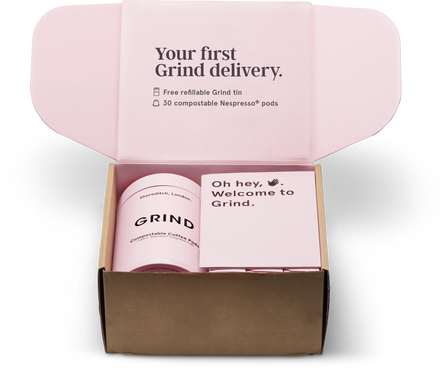Iced Latte vs Iced Coffee
We break down the differences between an Iced Latte and an Iced Coffee so you can impress your friends with all this very important new knowledge.
It’s (basically, nearly, kind of) summer. And we all know what that means: it’s cold coffee season. There’s nothing more refreshing than an iced coffee drink, but it’s probably time you learnt the difference between an iced coffee and an iced latte so that you know which to reach for when the weather gets warmer. Here’s hoping that the weather actually does get warmer.
What Is an Iced Latte?
Iced lattes are pretty popular these days. They’re simply the iced counterpart of a classic latte, an espresso topped with steamed milk. They consist of espresso, milk, and ice, and any additional flavouring or sweeteners you like (think caramel, brown sugar, vanilla, cinnamon etc.). It is typically made using ⅓ espresso and ⅔ cold milk. The milk content makes an iced latte a richer and creamier option than an iced coffee.
Our favourite examples of rich and creamy iced lattes? Our ready-to-drink Iced Caramel Latte and Iced Vanilla Oat Latte cans.
What Is an Iced Coffee?
An iced coffee features brewed coffee as its primary ingredient, but it can be made in a number of ways. It’s rare that you’ll just see “Iced Coffee” on a café menu—it’s more likely that you’ll see an array of options that offer an iced version of your favourite espresso-based drink. For example, iced flat whites, iced americanos, and iced lattes are all types of iced coffee.
Iced coffee on its own contains no milk. It’s either freshly-brewed espresso poured over ice or coffee that has been cold-brewed, a process in which ground coffee beans are steeped in cold water for at least 10 hours to preserve their natural flavours and aromas. It’s after this preparation process that you can choose to add milk, sugar, or other flavourings to your iced coffee.
A great example of an iced coffee? We’re so glad you asked. Our ready-to-drink Iced Long Black features our signature House Blend, slow-steeped in cold water to maintain all its delicious flavour.
What is the Difference between Iced Latte and Iced Coffee?
Put simply, an iced latte is made with espresso and milk, whilst an iced coffee is made with brewed coffee and can be served with or without milk. Let’s delve into five key points of comparison.
Ingredients
The most important difference between an iced latte and an iced coffee lies in their ingredients. Whilst an iced latte is defined by its milk content, an iced coffee is not necessarily a milk-based drink. Some iced coffee drinkers will order an iced coffee and add a splash of milk, but the milk quantity is much lower than with an iced latte and the ratio of milk vs espresso is different.
Most iced lattes feature a double shot of espresso and steamed milk that has been cooled down to create a smoother texture. A variety of sweeteners such as sugar and syrup can be added according to your personal taste preference, and then the mixture is poured over ice cubes.
The main ingredients of an iced coffee are, on the other hand, just brewed coffee and ice cubes. Milk and sweeteners are optional, and turn your iced coffee into other iced coffee drinks like an iced flat white.
Preparation
To make an iced latte, you should use a rich double shot of espresso, whether that’s freshly pulled from an espresso machine, coffee pod machine, moka pot, cafetière (French press), or however you like to brew your coffee. This double shot should then be combined with steamed milk that has cooled down, plus any extra flavourings you fancy.
One of our favourite hacks is to use our Flavoured Compostable Coffee Pods, available in Caramel, Hazelnut, Vanilla, Mocha, and Pumpkin Spice, so that there’s already a subtle sweetness to your drink. You can then pour this mixture over ice and enjoy.
To make an iced coffee, you can either choose to cold-brew your coffee using our Cold Brew Bottle or freshly brew your espresso using your normal brewing method. Cold-brewing requires a little more patience (like, 12 hours more patience), but we think the end result is very much worth it.
Once the coffee has been brewed, you can use regular ice cubes or, and this is very much what we recommend, you can use coffee ice cubes to maintain the bold flavour of the iced coffee and prevent dilution. We have our own Ice Cube Tray for this very purpose. Once the coffee is chilled, you can choose to add milk or sweeteners.
Textures and Creaminess
The high milk content of an iced latte results in a smoother, richer texture when compared to an iced coffee. The type of milk you use will also impact how creamy the texture is—using whole milk will result in a creamier, fuller texture than using skimmed milk or almond milk, for example. Iced coffees contain little to no milk, so the texture is typically lighter.
Flavour
The taste profiles of iced lattes and iced coffees are also different due to the differing ratios of milk to espresso. Iced lattes tend to have a more mellow, sweet taste as the milk balances the espresso, whereas iced coffees are generally more bitter and robust as a result of the higher coffee content. If hot water is used in the brewing process of iced coffee, rather than cold-brewing, it will likely have a stronger, more acidic taste before any milk is added.
The type of coffee used will impact the flavour. For instance, our Light Blend is a light roast that exhibits fruitier, brighter flavours whilst our House Blend is a smooth and chocolatey medium roast and our Dark Blend a rich and heavy-bodied dark roast.
Other ingredients will also affect the flavour profile of your drink. From using alternative milks like oat, almond, or hemp to adding caramel or vanilla syrups, the taste of an iced latte or iced coffee will vary.
Caffeine Content
Iced coffees tend to have more caffeine since they contain more coffee than iced lattes. Caffeine content will vary depending on the strength of the coffee and the number of espresso shots you use. If you’re looking for a low caffeine option, we’d recommend trying out our Decaf Coffee Pods or Decaf Whole Bean and Ground Coffee.
Which Is Healthier, Iced Lattes or Iced Coffee?
Although calorie content will vary depending on what kind of milk you use, an iced latte will contain more calories due to its higher milk content. On the other hand, iced coffee will have fewer calories as it contains less, or no, milk.
Choosing skimmed milk, almond milk, coconut milk, or soy milk can lower the calorie content of your iced latte, but it’s important to use unsweetened versions of these drinks as sweetened varieties often contain a lot of sugar.
Adding sweeteners or flavourings will also bring the calorie content up, so using natural sweeteners can be a healthier option compared to adding sugar. It's a good think our flavoured coffee pods are sugar-free.
Whilst coffee itself isn’t necessarily unhealthy, it’s important to stay aware of how much caffeine you’re consuming and to incorporate your iced lattes or iced coffees into a balanced and healthy diet. You can read more about the health benefits of coffee here.
Can I Make an Iced Latte or Iced Coffee at Home?
The answer to this is most definitely yes. In fact, we encourage it. We have a ton of iced coffee recipes on our website, including how to make a caramel iced coffee or a vegan iced coffee, and we have all the equipment you need:
Shop our Grind Two Coffee Pod Machine.
Shop our Cafetière.
Shop our Milk Frother.
Shop our Cold Brew Bottle.
Shop our Cold Brew Coffee Concentrate.
Shop our Ice Cube Tray.
Shop our Bean & Ground Coffee.
Shop Compostable Coffee Pods.
Feeling lazy? Shop our ready-to-drink Iced Coffee Cans.









































Comments
So interesting!
I love the iced caramel latte can!
Interesting read!